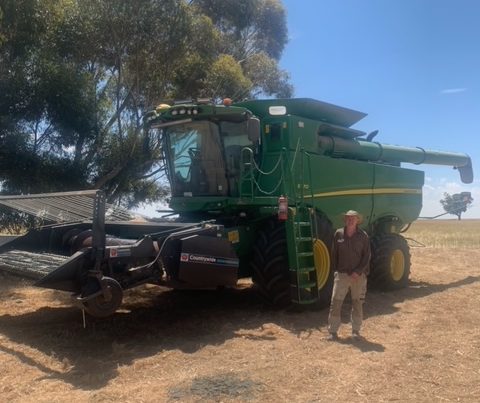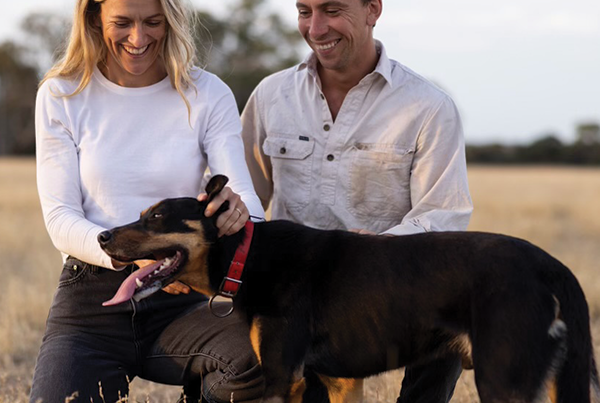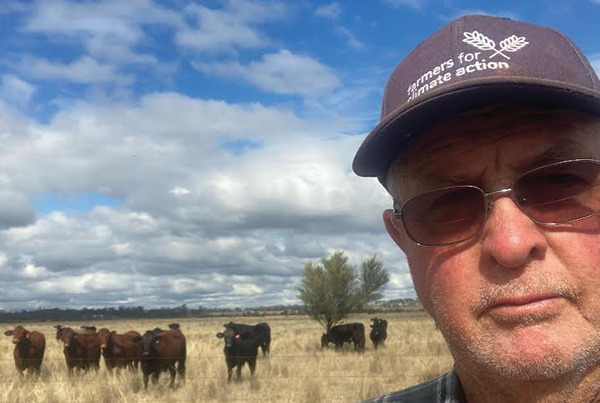To celebrate the amazing work underway in farms across Australia, we have launched a ‘Climate-Smart Farmer in Focus’ initiative. Each month, we select one of our farmer members who are doing great things on-farm to profile and learn from.
This month, we’ve turned our attention to West Australia farmer Simon Wallwork who is working hard to build a resilient farming system.
At a glance
Who: Simon Wallwork
What: 3700 hectare broadacre property, with 80% dedicated to cropping and 20% livestock
Where: Corrigin, 250 kilometres east of Perth, Western Australia
Can you tell us about your property?
My partner Cindy Stevens and I run a large broadacre property, with about 55 per cent dedicated to barley, 15 per cent canola and 10 per cent each to wheat and lupins. The remaining 20 per cent is used to run about 600 Merino ewes and 200 Murray Grey cows. The property includes Cindy’s original family farm, which we’ve added to over time by leasing and purchasing land. Our annual rainfall is 340mm. Our aim is to build a resilient farming system, which means we’re open to making changes.
What first got you thinking about climate change?
Climate change was touched on during my studies of Agriculture Science in the early 1990s. It became a bit more real for me when travelling through Canada and seeing the reduction in a glacier near Jasper in the Canadian Rocky Mountains. As my farming career has progressed I have become more aware of the trends and became involved in the climate champion program. This experience gave me exposure to climate science and other farmers around Australia observing changes in the climate. I like to think I base my decisions in farming on science including climate science and this helps to form a view and make decisions based on the evidence.
How has climate change impacted on your farm business?
The main ways in which climate change has impacted our business is through a 15 per cent reduction in winter rainfall, which means a drier growing season, as well as more severe and later frost events.
What are some of the climate-smart strategies you’ve been employing and how successful have they been?
We’ve put in place a number of strategies to deal with the changes in climate we’re experiencing. These include:
- Predominantly growing barley as a frost risk management strategy. We do this because barley is generally more frost tolerant than wheat.
- Spreading our frost risk by using a wide sowing window. We start early and spread sowing over two months, using dry seeding, to manage difficult starts
- Managing non-wetting soils by inverting it with mouldboard ploughing. That’s a strategy to improve the productivity of soils by increasing the moisture availability to crops particularly with drier season.
- Frost insurance. Last year we used frost insurance (AWB multi-peril crop insurance). We had a claim which covered our premiums for the year. I’m not sure if we’ll do the same again this year because the later break to the season means our crops will be flowering later which has reduced our frost risk this year.
- Diversifying our farm business with the introduction of livestock, which spreads our risk across commodities
- Burning stubbles. In the past we’ve retained our stubbles but now there’s good evidence you can reduce frost and enhance weed control. We acknowledge that burning stubble is a factor in agriculture’s emissions profile, but anything we do to reduce frost risk is important in the sustainability of our business.
- Using chemical fallow. This allows us to reserve moisture from one season to the next.
- Off-farm income. I carry out some agronomy work as well which gives us some stable income when times are tough on-farm
I think on-farm adaptation to climate change is critical – but I also know that we can only adapt so far. The industry needs to get on the front foot in terms of influencing policy for West Australian agriculture and agriculture at a national level. We’re adapting as we go, but we can’t keep doing it alone.





